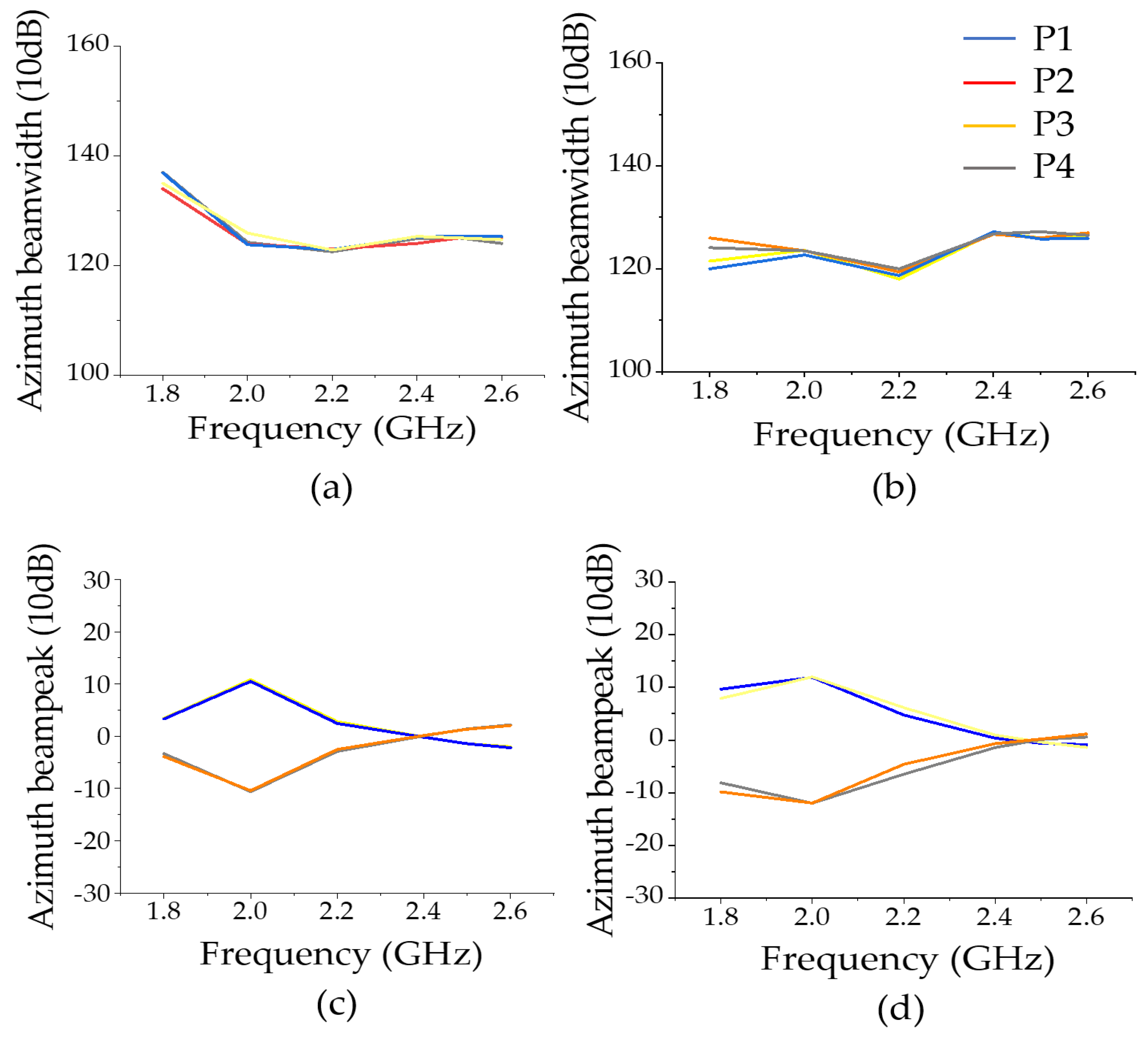A Simple and Effective Approach for Scattering Suppression in Multiband Base Station Antennas
Abstract
:1. Introduction
2. Low Band Horizontal and Vertical Configuration
3. Virtual Slant Polarizations
4. Low Band Element
5. Conclusions
Author Contributions
Funding
Conflicts of Interest
References
- Osseiran, A.; Parkvall, S.; Persson, P.; Zaidi, A.; Magnusson, S.; Balachandran, K. 5G Wireless Access: An Overview; 1/28423-FGB1010937; Ericsson: Stockholm, Sweden, 2020. [Google Scholar]
- Kelly, I.; Zimmerman, M.; Butler, R.; Zheng, Y. Base Station Antenna Selection for LTE Networks. 2017. Available online: https://www.commscope.com/globalassets/digizuite/2096-bsa-selection-for-lte-networks-wp-108976.pdf?r=1 (accessed on 1 September 2022).
- Mandhyan, A. 4G and 5G Capacity Solutions-Comparative Study. 2019. Available online: https://telecoms.com/intelligence/4g-and-5g-capacity-solutions-comparative-study/ (accessed on 1 September 2022).
- Huang, H.; Liu, Y.; Gong, S. A Novel Dual-Broadband and Dual-Polarized Antenna for 2G/3G/LTE Base Stations. IEEE Trans. Antennas Propag. 2016, 64, 4113–4118. [Google Scholar] [CrossRef]
- Huang, H.; Liu, Y.; Gong, S. A Dual-Broadband, Dual-Polarized Base Station Antenna for 2G/3G/4G Applications. IEEE Antennas Wirel. Propag. Lett. 2017, 16, 1111–1114. [Google Scholar] [CrossRef]
- He, Y.; Pan, Z.; Cheng, X.; He, Y.; Qiao, J.; Tentzeris, M.M. A Novel Dual-Band, Dual-Polarized, Miniaturized and Low-Profile Base Station Antenna. IEEE Trans. Antennas Propag. 2015, 63, 5399–5408. [Google Scholar] [CrossRef]
- He, Y.; Tian, W.; Zhang, L. A novel dual-broadband dual-polarized electrical downtilt base station antenna for 2G/3G applications. IEEE Access 2017, 5, 15241–15249. [Google Scholar] [CrossRef]
- Elsherbini, A.; Wu, J.; Sarabandi, K. Dual Polarized Wideband Directional Coupled Sectorial Loop Antennas for Radar and Mobile Base-Station Applications. IEEE Trans. Antennas Propag. 2015, 63, 1505–1513. [Google Scholar] [CrossRef]
- Sun, H.H.; Ding, C.; Zhu, H.; Jones, B.; Guo, Y.J. Suppression of Cross-Band Scattering in Multiband Antenna Arrays. IEEE Trans. Antennas Propag. 2019, 67, 2379–2389. [Google Scholar] [CrossRef]
- Isik, O.; Gripo, P.; Thalakotuna, D.; Liversidge, P. Cloaked Low Band Elements for Multiband Radiating Arrays. US Patent 10 439 285 B2, 16 October 2019. [Google Scholar]
- Soric, J.C.; Monti, A.; Toscano, A.; Bilotti, F.; Alu, A. Dual-Polarized Reduction of Dipole Antenna Blockage Using Mantle Cloaks. IEEE Trans. Antennas Propag. 2015, 63, 4827–4834. [Google Scholar] [CrossRef]
- Zhang, Y.; Zhang, X.Y.; Ye, L.; Pan, Y. Dual-Band Base Station Array Using Filtering Antenna Elements for Mutual Coupling Suppression. IEEE Trans. Antennas Propag. 2016, 64, 3423–3430. [Google Scholar] [CrossRef]
- Zhao, L.; Wu, K. A Dual-Band Coupled Resonator Decoupling Network for Two Coupled Antennas. IEEE Trans. Antennas Propag. 2015, 63, 2843–2850. [Google Scholar] [CrossRef]
- Zhu, Y.; Chen, Y.; Yang, S. Decoupling and Low-Profile Design of Dual-Band Dual-Polarized Base Station Antennas Using Frequency-Selective Surface. IEEE Trans. Antennas Propag. 2019, 67, 5272–5281. [Google Scholar] [CrossRef]
- Lalbakhsh, A.; Mohamadpour, G.; Roshani, S.; Ami, M.; Roshani, S.; Sayem, A.S.M.; Alibakhshikenari, M.; Koziel, S. Design of a Compact Planar Transmission Line for Miniaturized Rat-Race Coupler With Harmonics Suppression. IEEE Access 2021, 9, 129207–129217. [Google Scholar] [CrossRef]
- Ding, C.; Sun, H.; Zhu, H.; Guo, Y. Achieving Wider Bandwidth with Full-Wavelength Dipoles for 5G Base Stations. IEEE Trans. Antenna Propag. 2020, 68, 1119–1127. [Google Scholar] [CrossRef]











| No. | Acronym | Description |
|---|---|---|
| 1 | HB | High band |
| 2 | LB | Low band |
| 3 | BSA | Base station antenna |
| 4 | LBHV | Low band horizontal–vertical |
| 5 | HPBW | Half power beamwidth |
| 6 | HD | Horizontal dipole |
| 7 | VD | Vertical dipole |
| 8 | TL | Transmission line |
| References | Modification Type to Improve Isolation | Frequency Band (GHz) | Isolation (dB) | HPBW (Measured) |
|---|---|---|---|---|
| [4] | Metal baffles | 0.77–0.98 1.65–2.9 | >23 17.5 | 64.5 ± 57.1° 84.4 ± 74.1° |
| [5] | Arc-shaped baffle plates | 0.74–0.96 1.7–2.6 | >27.5 | 61.5° 90° |
| [9] | Chokes in LB element | 0.82–1 1.71–2.28 | NG | 69.5 ± 4° 65 ± 5° |
| [12] | Filtering antenna elements | 1.71–1.88 1.9–2.17 | >30 | 65 ± 5° |
| Proposed Antenna | No added structure | 0.69–0.96 1.8–2.6 | >36 >20 | 60 ± 5° 65 ± 11° |
| Parameters. | Values LB-HD (mm) | Values LB-VD (mm) | Description |
|---|---|---|---|
| W-SL | 6.5 | 10 | Width of SL |
| L-SL | 95 | 95 | Length of SL |
| W-TL1 | 8.5 | 8.5 | Width of TL1 |
| L-TL1 | 17 | 17 | Length of TL1 |
| W-TL2 | 2 | 3 | Width of TL2 |
| L-TL2 | 60 | 50 | Length of TL2 |
| W-OL | 4 | 5 | Width of OL |
| L-OL | 18 | 17 | Length of OL |
| g | 19 | 13 | Gap between SL |
Publisher’s Note: MDPI stays neutral with regard to jurisdictional claims in published maps and institutional affiliations. |
© 2022 by the authors. Licensee MDPI, Basel, Switzerland. This article is an open access article distributed under the terms and conditions of the Creative Commons Attribution (CC BY) license (https://creativecommons.org/licenses/by/4.0/).
Share and Cite
Farasat, M.; Thalakotuna, D.; Hu, Z.; Yang, Y. A Simple and Effective Approach for Scattering Suppression in Multiband Base Station Antennas. Electronics 2022, 11, 3423. https://doi.org/10.3390/electronics11213423
Farasat M, Thalakotuna D, Hu Z, Yang Y. A Simple and Effective Approach for Scattering Suppression in Multiband Base Station Antennas. Electronics. 2022; 11(21):3423. https://doi.org/10.3390/electronics11213423
Chicago/Turabian StyleFarasat, Madiha, Dushmantha Thalakotuna, Zhonghao Hu, and Yang Yang. 2022. "A Simple and Effective Approach for Scattering Suppression in Multiband Base Station Antennas" Electronics 11, no. 21: 3423. https://doi.org/10.3390/electronics11213423
APA StyleFarasat, M., Thalakotuna, D., Hu, Z., & Yang, Y. (2022). A Simple and Effective Approach for Scattering Suppression in Multiband Base Station Antennas. Electronics, 11(21), 3423. https://doi.org/10.3390/electronics11213423







